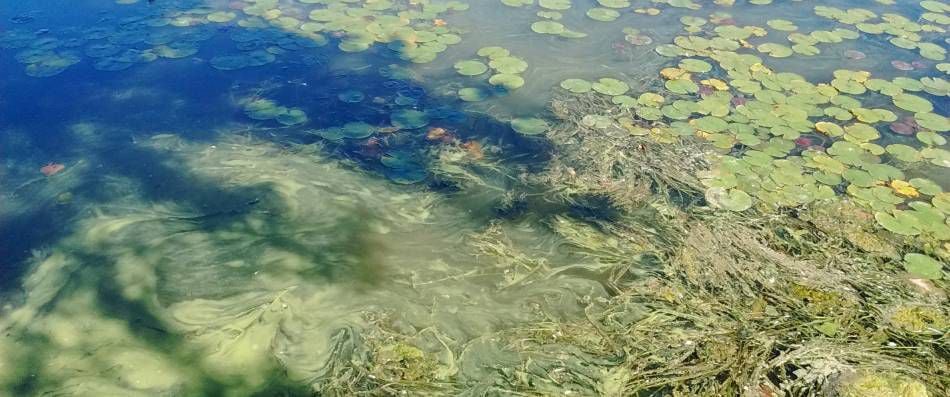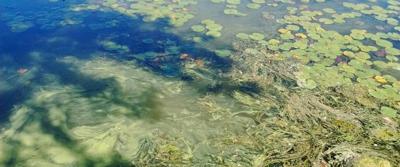AUBURN — Local leaders left a meeting with state officials about blue-green algae toxins in Owasco Lake Friday afternoon with a general feeling of positiveness.Â
The meeting started around 3 p.m. in a caucus room in the Cayuga County Office Building. It ended approximately an hour and 15 minutes later, with officials from the town of Owasco, city of Auburn and county gathering to debrief apart from the state Department of Environmental Conservation representatives, who came in person. Officials from the state Department of Health and Department of Agriculture & Markets were present on the phone.
Keith Batman, chairman of the Cayuga County Legislature, said while the meeting did not generate any specific promises from the state, he felt officials were aware of the problem Owasco Lake and the residents that receive their drinking water from it, are facing.Â
People are also reading…
Blue-green algae blooms that are toxic are called harmful algal blooms, and when they die, they release microcystin, a toxin that when ingested can cause liver failure and damage to kidneys, not to mention nausea, vomiting, headache, skin irritations and other health complications. While blue-green algae has made its way in the city of Auburn and town of Owasco's water treatment plants before, toxins have never made it into the treated drinking water — until this year. It was the first time in New York state that blue-green algae toxins had made it past the filters and into the treated water.
Blue-green algae, also known as cyanobacteria, is a filmy, paint-like scum that has been dis…
The levels tested in the treated water have been below the health advisory guidelines set by a 2015 study done by the U.S. Environmental Protection Agency. Still, toxins in the water caused concern both for residents and for local officials and treatment plant operators, scrambling to modify the water plants' procedures to get rid of as much of the toxin as possible. And while the plants have added more powder activated carbon and more chlorine, which has helped dramatically lower the toxin levels between the water coming in and the water being distributed, the goal is to have no toxins in the treated drinking water, said Eileen O'Connor, director of the county's Environmental Health Division.
"We assume that next year, there's going to be toxins in the lake again," O'Connor said.Â
She said the group did ask the state to fund engineering assessments and reports so that more modifications can be made to both treatment facilities. Batman said while the state did not promise any funds outright, he said the information was "well received."
The group also discussed long-term strategies for tackling blue-green algae on the lake. Two proposals have appeared, one from the city of Auburn and one from the county. Auburn City Council passed a resolution Thursday evening asking Gov. Andrew Cuomo to implement a Total Maximum Daily Load, though the resolution did not specify on what. Meanwhile, the Owasco Watershed Management Council has begun a Nine Element Watershed Plan, which covers a wide range of pollution sources and takes two years less to implement than a Total Maximum Daily Load, but it does not seem to have the same enforcement capabilities.Â
Jacqueline Lendrum, a research scientist with the DEC, said the first steps for both plans are the same. Once the DEC and others do an assessment of the lake including its health and land use, the team will identify priorities. From there they will decide whether a Nine Element Watershed Plan, Total Maximum Daily Load, or a combination of the two will be the best route for Owasco Lake, Lendrum said.
Debby McCormick, Auburn city counselor, said the meeting was also helpful because the group met officials directly working on the problems.
"We've got faces, names, and we know who to go to," she said.
That's how town of Owasco Supervisor Ed Wagner felt. Wagner said his main concern is getting the water treatment plants ready for next year's algal bloom season. He said new designs and engineering can take months, have a lot of red tape, and he hopes the state will allow them to bypass those procedures.
"It's the beginning," Wagner said about the meeting. "It puts a name to the face and it also gave us a context so that if we're not happy, we can pick up the phone and we know who to call. They all seem to want to help, and they're there for the same reason we are — for the protection not just of our lake but all lakes."Â
Staff writer Gwendolyn Craig can be reached at (315) 282-2237 or gwendolyn.craig@lee.net. Follow her on Twitter @gwendolynnn1.































